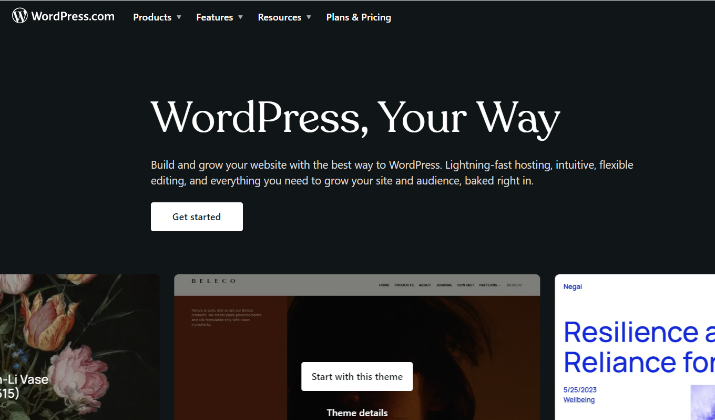When it comes to creating and managing content online, two popular platforms stand out: Substack and WordPress.
Both have their unique strengths and weaknesses, making it crucial for content creators to understand the differences between them.
Substack is a newsletter-centric platform designed for writers and journalists to publish and monetize their newsletters, while WordPress is a versatile content management system (CMS) that allows users to create and manage various types of websites and blogs.
In this article, we will delve into the key differences between Substack and WordPress, exploring their features, ease of use, and suitability for different content creation needs.
Let’s begin!
What is Substack?
Substack is an American online platform that allows journalists, writers, and other content creators to publish newsletters and establish a subscription-based audience.
The platform provides a comprehensive solution for personal publishing, offering a range of tools for creating and distributing content, managing subscriptions, and monetizing content through subscriptions.
Key features include a customizable website for publishing and managing content, email newsletters, community features for reader engagement, and podcast and video hosting capabilities.
Overall, Substack is an ideal platform for content creators who want to establish a direct connection with their audience and monetize their content through subscriptions.
With its comprehensive set of features, Substack provides a robust solution for personal publishing, enabling authors to focus on creating high-quality content while the platform handles the technical and administrative aspects of publishing.
Also read: 10 Best Beehiiv Alternatives
Understanding WordPress
WordPress is a free and open-source content management system (CMS) that allows users to create and manage dynamic websites and blogs.
With WordPress, users can create any type of website they want, from personal blogs to complex portals and enterprise websites.
WordPress offers a range of features that make it easy to manage content, including the ability to create posts and pages, format content, insert media, and schedule publication.
With thousands of plugins and themes available, WordPress provides a nearly limitless range of possibilities for customizing and extending its functionality.
With its ease of use, flexibility, and extensive community support, WordPress is an ideal platform for individuals and businesses looking to create and manage dynamic websites and blogs.
Check out: Is Beehiiv Free?
Design & Customization
Since Substack and WordPress cater to different needs and preferences, there are notable variations in their design and customization capabilities.
Substack
- Limited Design Options: Substack provides limited design options, with pre-designed templates for newsletters.
- Streamlined Interface: Substack’s interface is designed for simplicity and ease of use, focusing on content creation and distribution.
- Newsletter-centric: Substack is optimized for newsletter content, with features like formatting and media management tailored for this purpose.
WordPress
- Extensive Customization Options: WordPress offers extensive customization options through themes, plugins, and modules, allowing users to tailor their website to their specific needs.
- Themes and Templates: WordPress has a vast library of themes and templates, providing a wide range of design options for users.
- Custom Code: WordPress allows users to add custom code for advanced customization and integration with other tools and services.
- Responsive Design: WordPress themes are designed to be responsive, ensuring that websites adapt to different devices and screen sizes.
In short, Substack is designed for simplicity and ease of use, focusing on newsletter content creation and distribution.
WordPress, on the other hand, offers extensive customization options, making it suitable for users who want to create a wide range of websites.
Explore: Substack vs Ghost
Ease of Use
Let’s take a look into how these two platforms score in terms of ease of use.
Substack
- Substack is designed with simplicity in mind, making it an attractive option for content creators who want to focus on writing and engaging with their audience.
- The platform offers a user-friendly interface with a straightforward content creation and publishing process.
- Substack requires minimal technical knowledge, allowing users to get started quickly without needing to worry about web hosting, domain management, or complex website setup.
- The platform handles all the backend infrastructure, freeing users to concentrate on producing and distributing their content.
WordPress
- While WordPress is renowned for its user-friendliness, it does require a steeper learning curve compared to Substack.
- Setting up a WordPress website involves tasks like choosing a web host, installing the software, and configuring various settings.
- WordPress offers extensive customization options through themes and plugins, but this flexibility also means users need to invest time in understanding how to leverage these features.
- For users with limited technical expertise, the initial setup and management of a WordPress site can be more challenging than the streamlined experience offered by Substack.
Substack’s simplicity and beginner-friendly approach make it an excellent choice for writers and creators who prioritize a seamless content publishing experience.
WordPress, while more complex, offers unparalleled customization and control, making it a preferred option for users who are willing to invest the time and effort to build and manage a more comprehensive online presence.
Read this too: Beehiiv vs Ghost
Monetization Options
It is crucial to assess the monetization capabilities of platforms if you are serious about generating revenue from your content.
Here are the monetization options you get with Substack and WordPress.
Substack: Subscription-Based Monetization
- Substack’s primary monetization model revolves around paid newsletter subscriptions.
- Writers and creators can offer both free and paid subscription tiers, allowing them to monetize their content directly.
- Substack takes a 10% cut of all paid subscription revenue, making it a straightforward and transparent revenue-sharing model.
- This subscription-based approach enables Substack users to build a loyal following and generate predictable income from their content.
WordPress: Diverse Monetization Opportunities
- WordPress offers a wide range of monetization options beyond just subscriptions.
- Users can integrate various monetization plugins and services, including:
- Advertising: Displaying ads on their website through platforms like Google AdSense or custom ad networks.
- Ecommerce: Selling physical or digital products, services, or memberships.
- Donations: Accepting one-time or recurring donations from their audience.
- Sponsorships: Partnering with brands for sponsored content or placements.
- Affiliate marketing: Earning commissions by promoting third-party products or services.
- The flexibility of WordPress allows users to experiment with different monetization strategies and diversify their revenue streams.
Substack’s subscription-based model provides a clear and streamlined path to monetization, making it an attractive option for writers and creators who want to focus on building a paid subscriber base.
WordPress, on the other side, offers a more comprehensive and diverse set of monetization options, catering to a wider range of business models and content types.
You might like this: Beehiiv vs Substack
Technical Requirements
When it comes to the technical aspects of content creation and management, the differences between Substack and WordPress become quite apparent.
Substack
Substack is a hosted platform, meaning users don’t have to worry about the technical aspects of web hosting, domain management, or server maintenance.
To get started on Substack, users only need to create an account and start writing their newsletter content.
The platform handles all the backend infrastructure, including email delivery, subscription management, and payment processing.
Substack requires minimal technical knowledge from its users, making it an attractive option for writers, journalists, and creators who want to focus on content creation rather than website management.
WordPress
WordPress is a self-hosted platform, which means users need to set up their own web hosting and domain name.
Setting up a WordPress website involves tasks such as:
-
- Choosing a web hosting provider
- Installing the WordPress software
- Configuring settings like permalinks, plugins, and themes
- Maintaining the website, including regular updates and security measures
While WordPress has become more user-friendly over the years, it still requires a higher level of technical expertise compared to Substack.
Substack’s low-maintenance and beginner-friendly approach makes it an excellent choice for users who want to focus on content creation without getting bogged down by technical complexities.
WordPress, with its self-hosted nature and customization capabilities, caters to users who are willing to invest the time and effort to build and manage a more comprehensive online presence.
Also read: Beehiiv vs Mailchimp
Community Building
Building a community around your content is crucial for engagement, loyalty, and ultimately, success.
When it comes to community building, Substack and WordPress take different approaches, each with its own strengths and limitations.
Substack
- Substack’s primary focus is on creating a direct connection between content creators and their audience through newsletters.
- The platform encourages community engagement through comments and discussions within newsletters.
- Substack’s user-friendly interface and streamlined content creation process make it easy for writers to engage with their audience.
WordPress
- WordPress offers a range of community building tools and plugins, including:
- Comments: Built-in commenting system for user engagement.
- Forums: Dedicated spaces for discussions and community interaction.
- Social Media Integration: Integration with social media platforms for increased visibility and engagement.
- Membership Plugins: Tools for creating membership sites and exclusive content.
- Email Newsletters: Integration with email marketing services for targeted communication.
Substack’s focus on direct engagement through newsletters makes it an excellent choice for writers who want to build a loyal following and engage with their audience directly.
WordPress, on the other hand, offers a more comprehensive set of community building tools, making it suitable for users who need to manage multiple aspects of their online presence.
Check out: Beehiiv Review
Cost & Pricing
It’s time to explore their cost and pricing:
Substack
Substack is free to use at the start, allowing you to publish your newsletter, build your audience, and offer free content without incurring any costs.
However, once you introduce paid tiers, Substack takes a 10% cut of each subscriber’s payment.
This percentage remains constant, regardless of your income level. The final cost depends entirely on your subscriber base and revenue. As you grow, Substack’s share also increases.
WordPress
WordPress.com offers several different pricing plans for users:
- Free Plan: This is the most basic plan, which allows you to create a WordPress.com subdomain website (e.g. yoursite.wordpress.com). Suitable for personal, non-commercial use, it includes WordPress branding and limited customization options.
- Personal Plan: Priced at $4 per month, this plan removes WordPress branding and ads and allows you to use a custom domain (e.g. yoursite.com).
- Premium Plan: This plan is priced at $8 per month and it offers advanced customization options and email and live chat support.
- Business Plan: Available at $25 per month, this plan enables you to add ecommerce functionality and remove WordPress.com branding. It also includes Google Analytics integration.
- Commerce Plan: Priced at $45 per month, this plan has been optimized for online stores and merchants selling products. it comes with advanced ecommerce features and custom marketing automation.
- Cloud: This plan is available at $65 per month. It provides automated WordPress updates, global edge caching and unrestricted bandwidth.
- Enterprise: Designed for large organizations, the pricing for this plan starts at $25,000 per year.
Substack is free to start but has ongoing fees, while WordPress offers greater cost control but requires a larger upfront investment. The choice between the two platforms depends on your specific needs and budget.
Explore: Beehiiv vs MailerLite
Conclusion
If you want a versatile and powerful content management system that provides unlimited customization options, WordPress should be on your radar.
While Substack may be suitable for beginners or those primarily focused on newsletter creation, it falls short in terms of integrations and website building capabilities compared to WordPress.
WordPress caters to different website types, including blogs, ecommerce websites, and more, making it a versatile choice for businesses and individuals with varied online goals.














